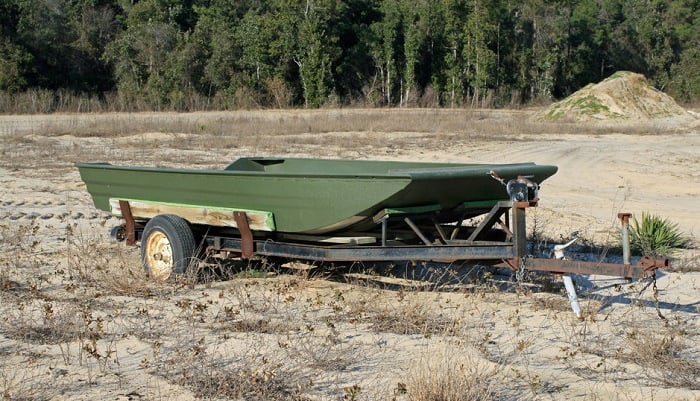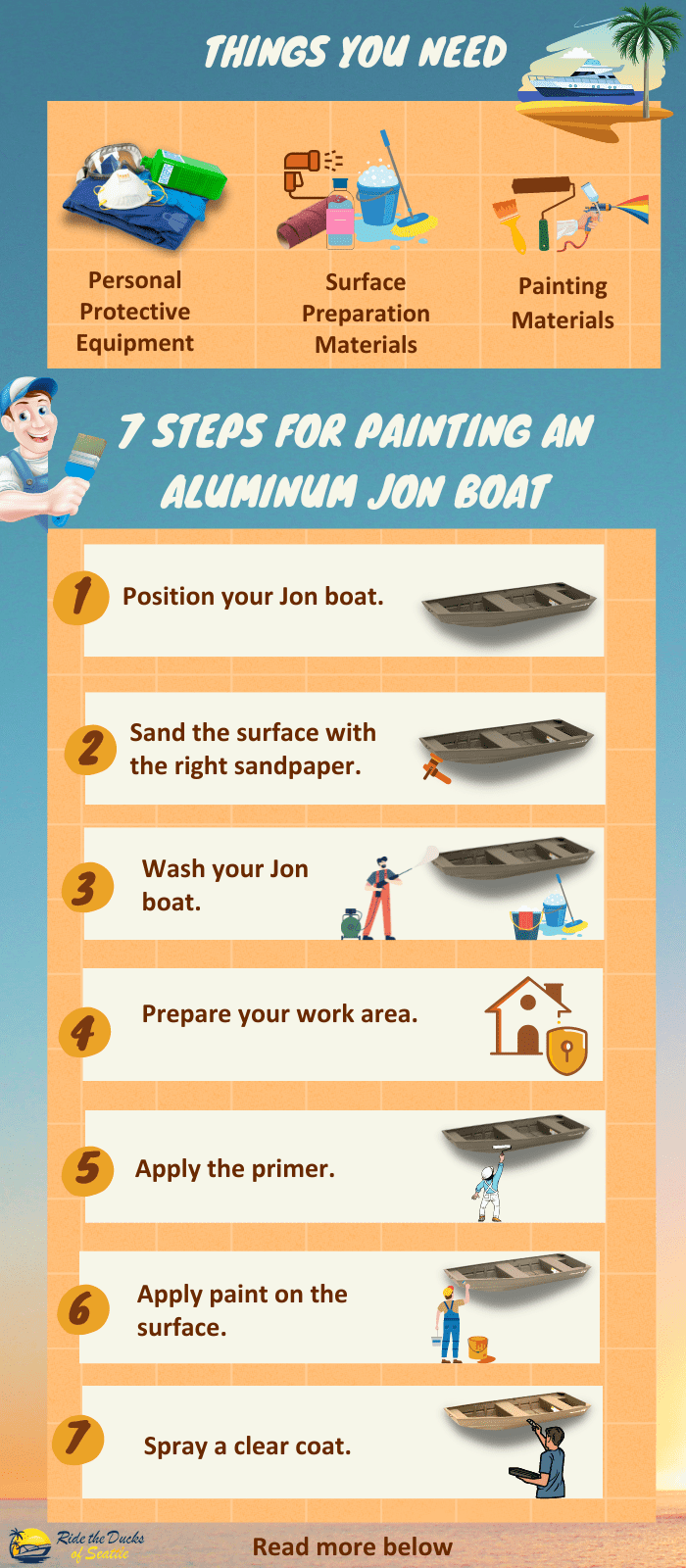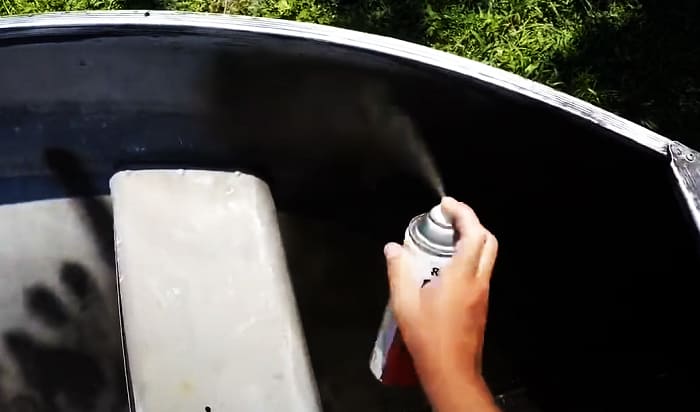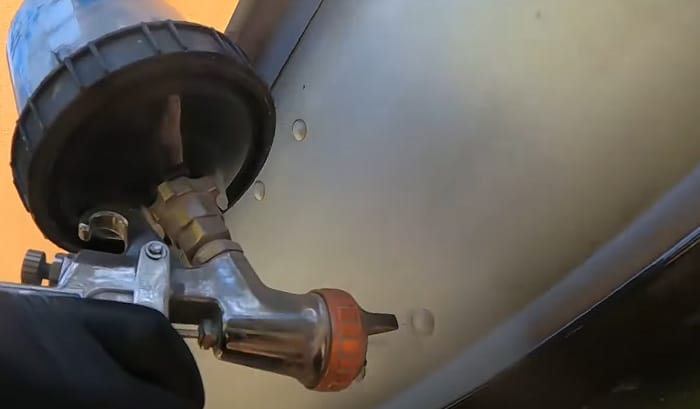Do you find barnacles, weeds, and other aquatic organisms building up under your aluminum Jon boat? Is there chipped or dull paint on the interior? These are two of the most common issues of aluminum Jon boats. You can solve them if you know how to paint an aluminum Jon boat.
Do not fret if you are clueless about how to paint a Jon boat because I will share an easy seven-step process for restoring your watercraft’s look and functionality, from sanding, and washing the boat to applying the primer and paint.
Things You Need for This Tutorial
Painting an aluminum Jon boat is not that different from other painting chores. You will need to prepare the work area and the surface before you start applying paint. It is also essential to have the following materials ready.
1. Personal Protective Equipment
Safety goggles, gloves, and a particle respirator mask are essential personal protective equipment when working with solvents and paints. You will not want to inhale chemical vapors because they can irritate your airways and lungs.
You will also sand the surface, sending dust, dirt, and other particles into the air. These substances can get into your eyes, or you can also inhale them. Some can also get on and irritate your skin.
2. Surface Preparation Materials
You cannot paint on a rough or damaged surface. That is why it is crucial to smoothen the surface and remove any chipped paint and debris.
That is why you will need a paint stripper or acetone to remove the old paint on your boat. Sandpaper is also essential, although you can also use an orbital sander.
A bucket full of soapy water, a stiff-bristled brush, and a power spray are also necessary to complete this task. You will also need plastic sheets or old newspapers to cover the work area and other objects.
3. Painting Materials
You will want water-resistant paint formulated especially for boats. The other materials you will need are a paint thinner, primer, and clear coat (optional). You can use a paint sprayer, paintbrush, or roller to apply the paint on your boat.
Steps for Painting an Aluminum Jon Boat
Step 1. Position your Jon boat.
Ideally, you will want to raise your aluminum boat to facilitate more efficient work. While aluminum Jon boats are lightweight, it would be best to ask a few people to help you lift the boat off the ground and rest it on stable mounts or blocks of sturdy wood.
Pro Tip: If you will only paint your boat’s bottom, it would be better to flip it upside down.
Step 2. Sand the surface with the right sandpaper.
It is ideal to prep the aluminum boat for paint before you apply any fresh paint. You will want the surface to be as clean as possible to ensure the proper paint pigment adhesion. It also minimizes chipping.
If the boat has a painted inside surface, sand the surface using 80-grit sandpaper. If the interior is bare aluminum, you can use 40-grit sandpaper. Remove any carpet or flooring material your boat may have and sand the surface until you get a smooth finish.
Pro Tip: You can also use a paint stripper or acetone before sanding to hasten the process.
Step 3. Wash your Jon boat.
After paint stripping and sanding, it is essential to wash your boat to remove any residue and particles. You can use a high-pressure water spray to blast those particles off.
Apply soapy water on the boat’s surface and scrub it thoroughly with a stiff-bristled brush.
Power-spray the boat again to rinse before allowing it to air dry completely.
Step 4. Prepare your work area.
Painting aluminum boat can splatter pigments on your floor. You can also spray other objects in the room if you do not cover or move these items.
Place large plastic sheets or old newspapers on the floor underneath and surrounding your Jon boat. Remove items you do not want to be sprayed with paint or cover them with plastic.
Open the windows if you are in an enclosed space to promote adequate ventilation. You might also want to use an electric fan to facilitate better air circulation.
Step 5. Apply the primer.
Check your primer’s directions for mixing with paint thinner. If there are no instructions, you can use a gallon of paint primer and add a pint of paint thinner. Mix well, scraping into the bottom to ensure homogeneity.
Fill a paint sprayer canister and coat the boat’s surface with the primer. If you do not have a paint sprayer, an ordinary paint brush or roller will suffice.
Start on the boat’s outside surface, letting the primer dry for at least eight hours before flipping the boat over to paint the inside.
Pro Tip: Always wear safety goggles and respirator masks when working with paints and solvents.
Step 6. Apply paint on the surface.
Use the same procedure we described in Step 5 to apply aluminum boat paint. Read the water-resistant paint’s directions for preparation and application before spraying, brushing, or rolling it on your Jon boat.
Paint one side first, allowing it to dry completely before turning the boat over to paint the other side.
Depending on your paint, you may have to apply at least two coats, ensuring complete drying between applications.
Pro Tip: Use a paintbrush to apply paint in hard-to-reach areas and boat corners.
Step 7. Spray a clear coat.
While not necessary, applying a clear coat over the aluminum Jon boat paint extends the pigment’s lifespan. The clear coat also serves as an additional protective layer for your boat.
It would be best to check the clear coat manufacturer’s instructions on applying the product to your boat. Most clear coat products come in spray bottles, which you must use at a certain distance from the surface.
Dude Lets Fish has a comprehensive video about sanding, washing, and painting a Jon boat I believe you will want to check out.
Conclusion
Whether to restore your boat’s finish or reinforce its functionality, learning how to paint an aluminum Jon boat is a skill you will want to have. Mastering this competency can help you paint other items in your home.
If you find this tutorial beneficial, you might want to let your friends and acquaintances know about it, too. I would also be glad to hear any comments or feedback you may have.

I am passionate about water sports and technical fields, so combining both makes me interested in making contents about boat accessories. With my partner, we went on many trips and sports games together, which led us to think about how we can spread our joys and passions to many people.




